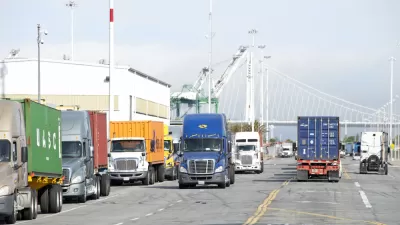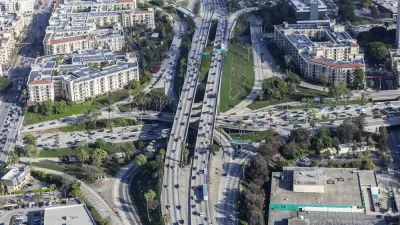The Los Angeles Times follows-up an earlier article on the dangers of building too close to freeways. It's a trade-off that the California Air Resources Board acknowledged last April with new guidelines that recognize the dire need for housing.
The post is based on a report by Tony Barboza and David Zahniser of the Los Angeles Times who wrote a follow-up on Dec. 27 that explains why the Air Resources Board (ARB) is willing to accept projects selected by the Strategic Growth Council even when the siting goes against their own recommendations.
And it's not just subsidized affordable housing developments being built too close to freeways.
Los Angeles "issued building permits for 4,300 homes near freeways in 2015 — more than in any year over the last decade — and signed off on an additional 3,000 units last year," reported Barboza and Jon Schleuss for the Times on March 2, 2017.
Last April, the board "issued a new advisory [pdf] that emphasizes design rather than distance, recommending anti-pollution features such as air filters, sound walls and thick vegetation as 'promising strategies' to reduce the health risks from freeways," write Barboza and Zahniser. Recommendations also include architectural and transportation mitigations, including street design and pedestrian and bicycle infrastructure:
Among the suggestions in the report: Lower speed limits to 55 mph or less and install roundabouts to reduce vehicle emissions. Design city streets with parks, bike lanes, wider sidewalks and buildings with “varying shapes and heights” to disperse traffic pollutants.
Those projects are challenging in cities like Los Angeles, “where freeways and major thoroughfares abound,” air board spokesman Stanley Young said. “In responding to that reality we felt it was important to give planners and developers information on how to mitigate the impacts,” he added.
However, ARB hasn't abandoned their 2005 handbook either. "That’s a very basic health position that the agency has taken and we still stand by,” said Kurt Karperos, a deputy executive officer for the air board,
Yet it's clear that ARB has become more flexible, evidenced in January 2016 when "air board chair Mary Nichols acknowledged that the push for dense urban development, which can reduce driving and overall emissions, also can 'result in increased exposures for people who live or go to school and spend any time outdoors in areas near roadways,'” add Barboza and Zahniser.
Housing activists and business leaders have cheered the new design advisory while public health and environmentalists bemoan them.
Alan Greenlee, executive director of the Southern California Assn. of Non-Profit Housing, said he is happy the state “seems to have moved in the direction of allowing building where previously they weren’t interested.” With filters and other anti-pollution measures, developers “can house people affordably and healthfully in areas where the government says there are air quality issues.”
Bill Magavern, policy director for the Coalition for Clean Air, has a far different perspective.
"New housing should be well planned so that it’s not putting residents’ health at risk,” he said. “The goal is to have the homes near transit, not near freeways.”
However, in a third piece, Barboza reports on Dec. 30 that exposure to harmful motor vehicle emissions is not just a matter of proximity to heavily traveled roads.
In the late night and early morning, it turns out, traffic pollution drifts much farther than during the day, and can extend more than a mile downwind from the freeway.
It’s not only your distance from traffic, but other details such as wind patterns, freeway design, the time of day and the types of cars, trucks and buildings around you that determine the risk.
This piece has lots of interesting information on how to mitigate exposure to traffic air pollution and what factors to look for that influence exposure.
FULL STORY: Regulators warned against housing near freeways due to health risks. Now they're warming to it

Study: Maui’s Plan to Convert Vacation Rentals to Long-Term Housing Could Cause Nearly $1 Billion Economic Loss
The plan would reduce visitor accommodation by 25,% resulting in 1,900 jobs lost.

North Texas Transit Leaders Tout Benefits of TOD for Growing Region
At a summit focused on transit-oriented development, policymakers discussed how North Texas’ expanded light rail system can serve as a tool for economic growth.

Alabama: Trump Terminates Settlements for Black Communities Harmed By Raw Sewage
Trump deemed the landmark civil rights agreement “illegal DEI and environmental justice policy.”

How Community Science Connects People, Parks, and Biodiversity
Community science engages people of all backgrounds in documenting local biodiversity, strengthening connections to nature, and contributing to global efforts like the City Nature Challenge to build a more inclusive and resilient future.

Alabama: Trump Terminates Settlements for Black Communities Harmed By Raw Sewage
Trump deemed the landmark civil rights agreement “illegal DEI and environmental justice policy.”

Dear Tesla Driver: “It’s not You, It’s Him.”
Amidst a booming bumper sticker industry, one writer offers solace to those asking, “Does this car make me look fascist?”
Urban Design for Planners 1: Software Tools
This six-course series explores essential urban design concepts using open source software and equips planners with the tools they need to participate fully in the urban design process.
Planning for Universal Design
Learn the tools for implementing Universal Design in planning regulations.
City of Santa Clarita
Ascent Environmental
Institute for Housing and Urban Development Studies (IHS)
City of Grandview
Harvard GSD Executive Education
Toledo-Lucas County Plan Commissions
Salt Lake City
NYU Wagner Graduate School of Public Service




























